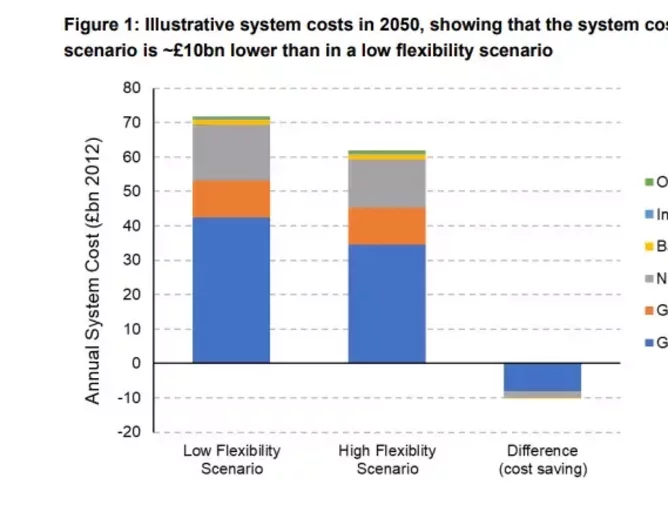UK unveils smart energy and energy digitalisation strategies

You wait a while for smart energy and digital strategies to arrive - and two come along at once. Yesterday was a landmark day in the UK energy sector as the Department for Business, Energy and Industrial Strategy released its Smart Systems and Flexibility Plan, developed by the government and Ofgem in coordination with the industry, and Energy Digitalisation strategy. Here the key points from both plans.
Smart Systems and Flexibility Plan
The key word that jumps out of the title, and Executive Summary, is flexibility. Consumers will be able to shift demand to times of day when electricity is cheaper and more abundant; variable renewable power will be stored for when it is needed, and the UK will import power from other countries when they have more available electricity than the UK does – and vice versa.
Energy Minister Lord Callanan said: "From looking at how something as simple as charging your electric car can cut your energy bill to making sure renewable energy can be stored for when it’s needed, this plan shows how we are using innovative technologies to meet our commitments on carbon emissions," he said.
An entire chapter (3) is dedicated to "Reforming markets to reward flexibility", exploring how electricity market arrangements can unlock the full benefits of flexibility and drive improvements. It is estimated that increased flexibility could reduce system costs between £30-70bn between 2020-2050, and by 2050 the domestic market for smart systems and flexibility solutions could be worth as much as £1.3 billion per year to GDP.
On the plus side, an important driver of flexibility requirements, the share of renewables in the generation mix, is rising year on year. This will continue to increase with the ambition of 40GW of offshore wind by 2030.

As always in overarching strategies, the numbers look appealing. Costs could be reduced by up to £10bn a year by 2050, by reducing the amount of generation and network we need to build to meet peak demand, and 24,000 jobs created by 2050.
But time is of the essence. It will be "very difficult" to achieve the deep power sector decarbonisation needed to achieve the sixth Carbon Budget without significantly higher levels of system flexibility, the document notes. The need for flexibility will rapidly increase as variable renewable power replaces fossil fuel sources, and we electrify heat and transport.
Around 30GW of total low carbon flexible capacity in 2030, and 60GW in 2050, may be needed to maintain energy security and cost-effectively integrate high levels of renewable generation.
Other key chapters are assigned to removing barriers to flexibility on the grid through electricity storage and interconnection; and Digitalising the system, highlighting the importance of data and digitalisation in managing the transition to a smarter and flexible energy system.
The big question surrounds practical deliverables. A new four-year smart meter policy framework will start January 1 2022, with fixed minimum annual installation targets for energy suppliers to deliver market-wide rollout. The UK Government will take powers to regulate energy smart appliances, to set requirements underpinned by the principles of interoperability, data privacy, grid stability and cyber security.
David Boundy, Chief Technology Officer and General Manager Europe at Innowatts, said it welcomed the Government and Ofgem's commitment to incentivising greater investment in data and digitalisation and hope it acts as a catalyst in supporting energy suppliers to adopt those technologies that will ultimately lead to better decisions for consumers, for the transition and their businesses.
“As the smart meter rollout progresses, energy suppliers have an ever increasing data resource at their fingertips – however, to date much of this data has remaining untapped, leaving opportunities to improve sustainability, grid reliability, risk management and customer service on the table. If we are to achieve a smart, flexible energy system that is fit for the future, unlocking consumer insights will be absolutely vital."
Sanjay Neogi, Head of UK and Europe at Enzen, welcomed the Smart Systems and Flexibility Plan and Energy Digitalisation Strategy, but said in order for the plans to be a success, we need to consider other key issues such as infrastructure challenges and network resilience.
"As more low carbon technologies become available, DNOs need to facilitate the integration of these renewable energy sources onto the grid in a sustainable, cost-effective way. With many utilities already facing cost constraints due to the challenging RIIO-ED2 regulatory framework, cutting-edge technologies will be vital to aid this transition," he said.
"However, we also need to ensure that safety, data quality and network resilience are kept at the forefront of these new initiatives. An increasing pressure to reduce carbon emissions, paired with rising populations, means many cities are looking towards these smarter, tech-driven solutions to bring them up-to-speed with 21st century challenges. The increased proliferation of these solutions – plus the huge volumes of data creation and management inherent in their design – mean stakeholders must prioritise cybersecurity in their plans."
Energy digitalisation strategy
The UK Government acknowledges that all parts of the energy system – demand, supply, markets, networks – need digitalising to create a more efficient ‘whole system approach’, but current services are underdeveloped and inconsistent.
A lack of incentives and "a culture rooted in keeping network and asset information private" have perpetuated an undervaluation or overprotection of data, leading to inaccurate and incomplete datasets, data silos and unnecessary data hoarding. "These can act as blockers to data exchange," it notes. "The sector has already taken good strides to overcome these barriers, but much more needs to be done." In short, data is more valuable when combined with other datasets.
To ensure better visibility of small-scale energy assets on the networks, the UK Government will make sure network companies work with other industries to simplify data collection at the point of asset registration.
Innovate UK has launched a £3m competition to deliver Modernising Energy Data Applications, that address the challenges faced by organisations and individuals to deliver net zero local energy systems. Ofgem plans to conduct a holistic review in winter 2021/22 to identify and understand new and existing data and digital monopolies.
The scale of change needed to digitalise the energy system is significant. It requires the integration of millions of new energy assets, each with a potentially different owner, the collaboration of multiple large and sometimes competing organisations, and new infrastructure capable of not only managing trillions of secure data flows, but predicting them, too.

This strategy focuses primarily on energy system data, relating to how the system operates, the markets that send signals to system users, and the physical infrastructure located on the networks (rather than consumer usage). The report highlights:
- Ofgem’s market-wide half-hourly settlement programme will require energy suppliers to securely process domestic consumers’ smart meter half-hourly consumption data for settlement and forecasting, whilst enabling consumers to opt-out from sharing data for these purposes.
- The Public Interest Advisory Group on access to smart meter data for a public interest purpose, coordinated by charities Sustainability First and Centre for Sustainable Energy, has been exploring how smart meter data, on an anonymised and aggregated basis, could support government and regulatory oversight of the energy transition and aid public policy making.
- The Smart Energy Research Lab11 is a secure virtual facility to access granular smart meter data, with consumer consent, to conduct research. This is allowing energy researchers to carry out valuable public interest work.
- Smart meter data supports Distribution Network Operators (DNOs) to efficiently plan and maintain the electricity network. Subject to approval of data privacy plans by Ofgem, DNOs can access half-hourly consumption data.
- Other relevant consumer data initiatives include Smart Data12 and Midata. Smart Data is the secure and consented sharing of consumer data with third parties who offer innovative services such as automatic switching and account management while Midata is a smart data initiative for the energy sector, led by Ofgem.
- The National Data Strategy sets out the government’s vision to harness the power of responsible data use to boost productivity, create new businesses and jobs, improve public services, support a fairer society, and drive scientific discovery.
Practical next steps
In the mid-2020s, standards and regulatory frameworks will be in place that ensure energy data collection and applications meet best practice and that data assets are treated as open and accessible by default while privacy and security is protected.
There will be a significant step-up in the visibility of assets across the system and new digital services will make it easier for people to know what data exists and how they can gain access to it.
By 2030 and beyond system operators will have visibility of all energy assets, making planning, forecasting and operations quicker, more accurate and cheaper. Greater data access in the marketplace will support new business models and services developing and new market entrants participating in the energy sector.
These new entrants will be able to tailor energy services to consumers using sophisticated digital platforms, address system needs via software rather than hardware, and create predictive models that prevent issues before they happen.






